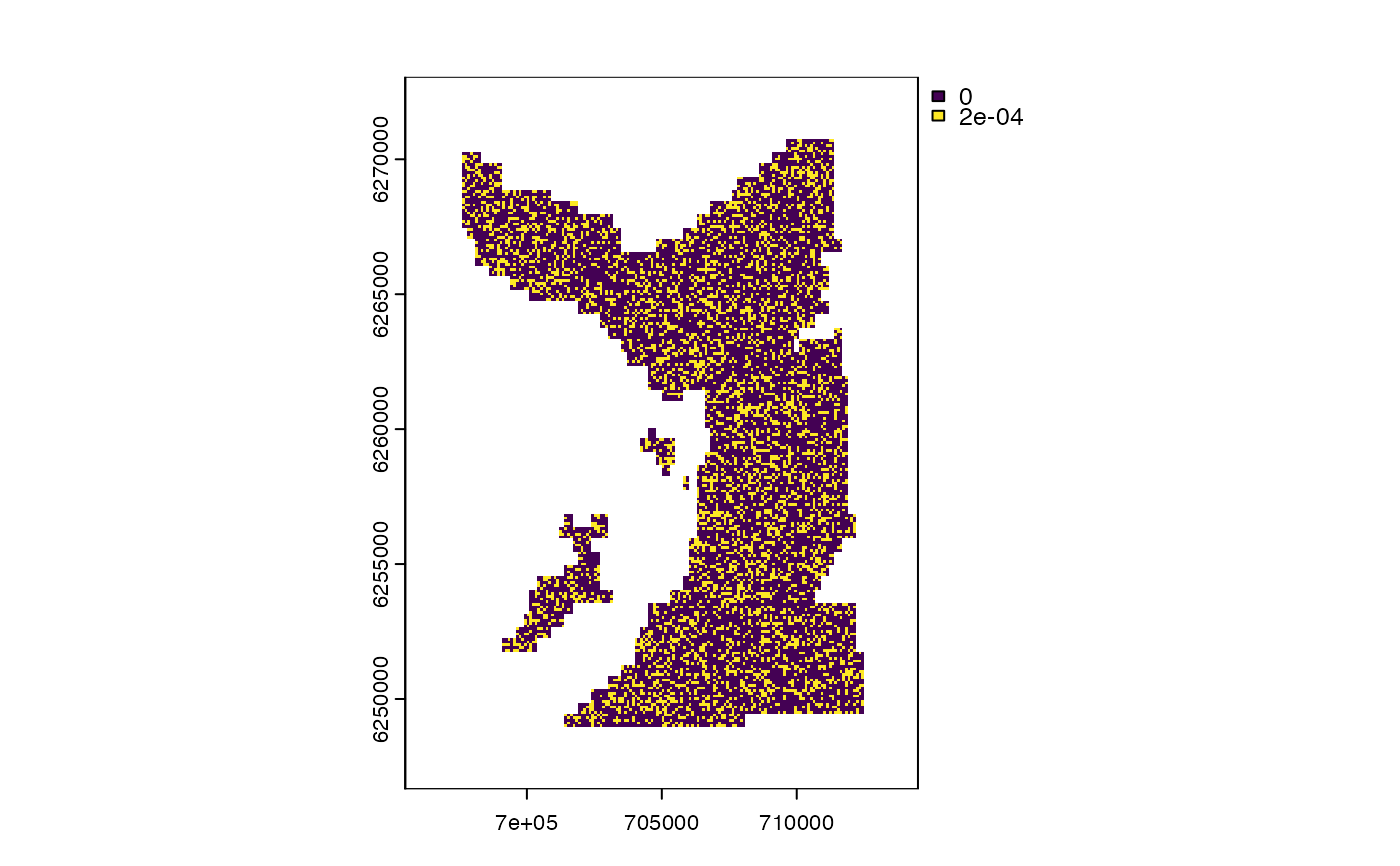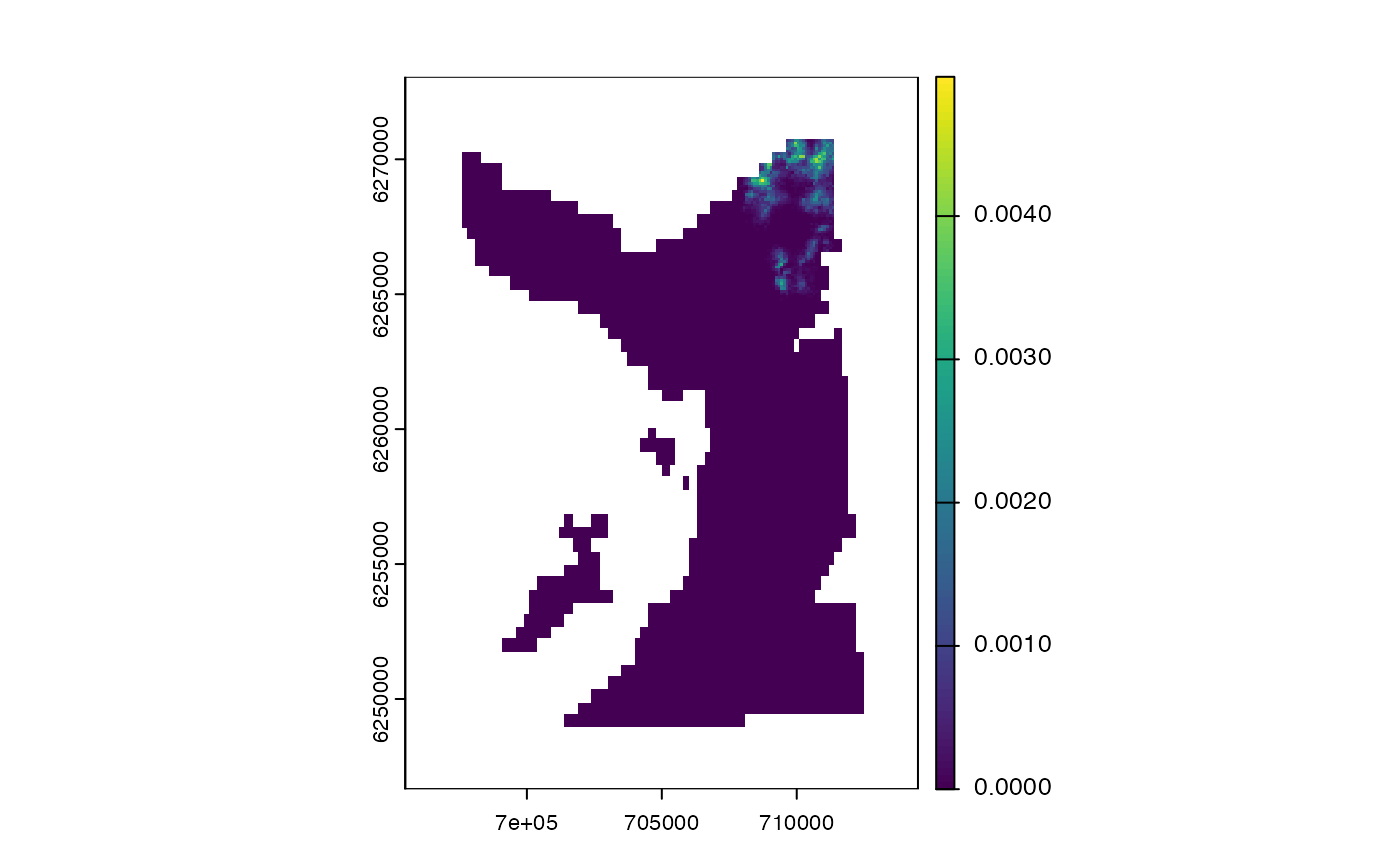This function builds a 'probability-of-use' utilisation distribution.
Usage
map_pou(
.map,
.coord,
.plot = TRUE,
...,
.verbose = getOption("patter.verbose")
)Arguments
- .map
A
terra::SpatRasterthat defines the grid for probability-of-use estimation.- .coord
Coordinates, provided in any format accepted by
.map_coord()- .plot, ...
A logical input that defines whether or not to plot the
terra::SpatRasterand additional arguments passed toterra::plot().- .verbose
User output control (see
patter-progressfor supported options).
Value
The function returns a named list with the following elements:
ud: a normalisedterra::SpatRaster;
Details
Probability-of-use is calculated via .map_coord() (and .map_mark()). If a single dataset of unweighted coordinates is provided, probability-of-use is simply the proportion of records in each grid cell. If a time series of unweighted coordinates is provided, probability-of-use is effectively the average proportion of records in each grid cell. This becomes a weighted average if coordinates are weighted. Weights are normalised to sum to one and the result can be interpreted as a utilisation distribution in which cell values define probability-of-use. Maps are sensitive to grid resolution.
This function replaces flapper::pf_plot_map().
On Linux, this function cannot be used within a Julia session.
See also
map_*() functions build maps of space use:
map_pou()maps probability-of-use;map_dens()maps point density;map_hr_*()functions map home ranges;
All maps are represented as terra::SpatRasters.
To derive coordinates for mapping patterns of space use for tagged animals, see:
coa()to calculate centre-of-activity;pf_filter()and associates to sample locations using particle filtering;
Examples
if (patter_run(.julia = FALSE, .geospatial = TRUE)) {
library(data.table)
library(dtplyr)
library(dplyr, warn.conflicts = FALSE)
#### Define map
map <- dat_gebco()
#### Example (1): Use sample coordinates
# Sample example coordinates
coord <-
map |>
terra::spatSample(size = 5000L, xy = TRUE, cell = TRUE, na.rm = TRUE) |>
select("x", "y") |>
as.data.table()
# Use x, y coordinates
map_pou(map, .coord = coord)
# Other formats are acceptable
map_pou(map, .coord = as.matrix(coord))
map_pou(map, .coord = as.data.frame(coord))
# `cell_x` and `cell_y` coordinates are acceptable
map_pou(map, .coord = coord[, .(cell_x = x, cell_y = y)])
#### Example (2): Use coordinates from `coa()`
# Use example dataset
coord <- dat_coa()
map_pou(map, .coord = coord)
points(coord$x, coord$y, cex = 0.5)
#### Example (3): Use a time series of coordinates from `pf_*()`
# Use example dataset
# * We use particles from the forward filter (`?pf_filter()`);
# * Particles are equally weighted b/c re-sampling is implemented every time step;
# * It is better to use outputs from the particle smoother;
coord <- dat_pff()$states
map_pou(map, .coord = coord)
# points(coord$x, coord$y, cex = 0.5)
}
#> `patter::map_pou()` called @ 2025-04-22 09:31:00...
#> ... Building XYM...
#> ... Building SpatRaster...
 #> `patter::map_pou()` call ended @ 2025-04-22 09:31:00 (duration: ~0 sec(s)).
#> `patter::map_pou()` called @ 2025-04-22 09:31:00...
#> ... Building XYM...
#> ... Building SpatRaster...
#> `patter::map_pou()` call ended @ 2025-04-22 09:31:00 (duration: ~0 sec(s)).
#> `patter::map_pou()` called @ 2025-04-22 09:31:00...
#> ... Building XYM...
#> ... Building SpatRaster...
#> `patter::map_pou()` call ended @ 2025-04-22 09:31:00 (duration: ~0 sec(s)).
#> `patter::map_pou()` called @ 2025-04-22 09:31:00...
#> ... Building XYM...
#> ... Building SpatRaster...
#> `patter::map_pou()` call ended @ 2025-04-22 09:31:00 (duration: ~0 sec(s)).
#> `patter::map_pou()` called @ 2025-04-22 09:31:00...
#> ... Building XYM...
#> ... Building SpatRaster...
#> `patter::map_pou()` call ended @ 2025-04-22 09:31:00 (duration: ~0 sec(s)).
#> `patter::map_pou()` called @ 2025-04-22 09:31:00...
#> ... Building XYM...
#> ... Building SpatRaster...
#> `patter::map_pou()` call ended @ 2025-04-22 09:31:00 (duration: ~0 sec(s)).
#> `patter::map_pou()` called @ 2025-04-22 09:31:00...
#> ... Building XYM...
#> ... Building SpatRaster...
#> `patter::map_pou()` call ended @ 2025-04-22 09:31:00 (duration: ~0 sec(s)).
#> `patter::map_pou()` called @ 2025-04-22 09:31:00...
#> ... Building XYM...
#> ... Building SpatRaster...
#> `patter::map_pou()` call ended @ 2025-04-22 09:31:00 (duration: ~0 sec(s)).
#> `patter::map_pou()` called @ 2025-04-22 09:31:00...
#> ... Building XYM...
#> ... Building SpatRaster...
 #> `patter::map_pou()` call ended @ 2025-04-22 09:31:00 (duration: ~0 sec(s)).
#> `patter::map_pou()` called @ 2025-04-22 09:31:00...
#> ... Building XYM...
#> ... Building SpatRaster...
#> `patter::map_pou()` call ended @ 2025-04-22 09:31:00 (duration: ~0 sec(s)).
#> `patter::map_pou()` called @ 2025-04-22 09:31:00...
#> ... Building XYM...
#> ... Building SpatRaster...
 #> `patter::map_pou()` call ended @ 2025-04-22 09:31:00 (duration: ~0 sec(s)).
#> $ud
#> class : SpatRaster
#> dimensions : 264, 190, 1 (nrow, ncol, nlyr)
#> resolution : 100, 100 (x, y)
#> extent : 695492.1, 714492.1, 6246657, 6273057 (xmin, xmax, ymin, ymax)
#> coord. ref. : WGS 84 / UTM zone 29N (EPSG:32629)
#> source(s) : memory
#> varname : dat_gebco
#> name : map_value
#> min value : 0.000000000
#> max value : 0.003333333
#>
#> `patter::map_pou()` call ended @ 2025-04-22 09:31:00 (duration: ~0 sec(s)).
#> $ud
#> class : SpatRaster
#> dimensions : 264, 190, 1 (nrow, ncol, nlyr)
#> resolution : 100, 100 (x, y)
#> extent : 695492.1, 714492.1, 6246657, 6273057 (xmin, xmax, ymin, ymax)
#> coord. ref. : WGS 84 / UTM zone 29N (EPSG:32629)
#> source(s) : memory
#> varname : dat_gebco
#> name : map_value
#> min value : 0.000000000
#> max value : 0.003333333
#>
